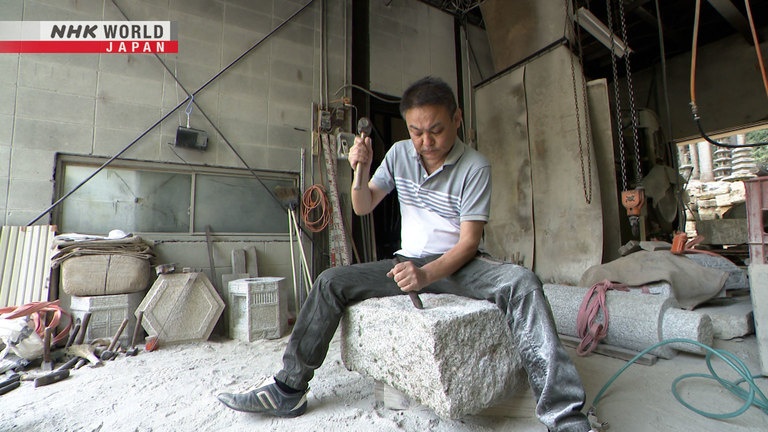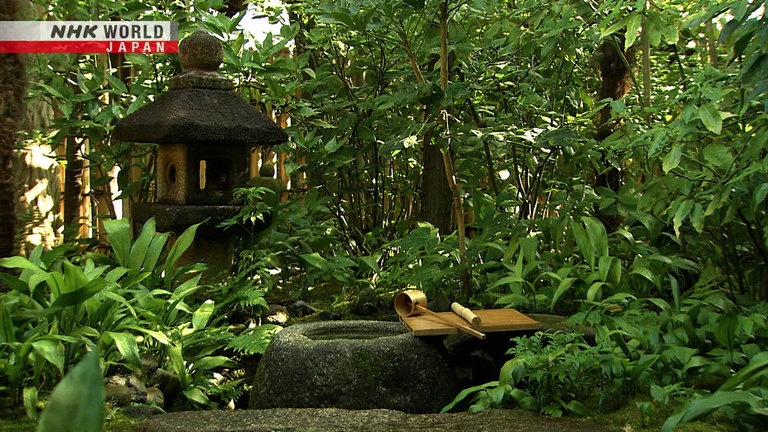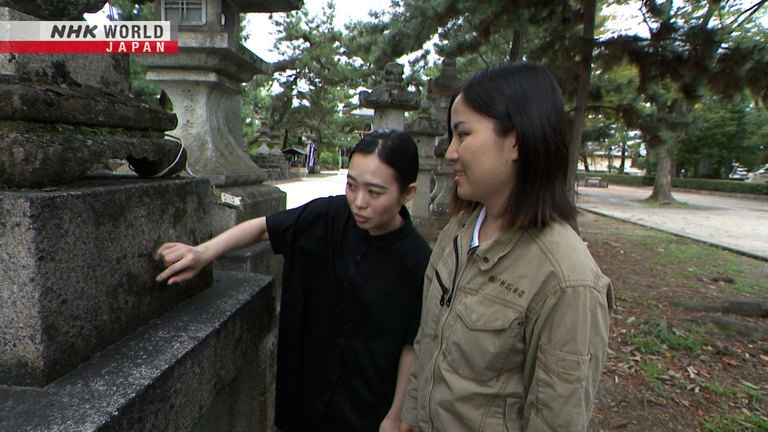Stonework: Masons Shape a Solid City Presence
Stone is a noticeable feature when walking through Kyoto's townscape: pavements, stairs, and religious statuary and objects. Stonemasons bring out the inherent beauty and qualities of their materials.




Transcript
Cobblestones enhance the atmosphere of Kyoto streets.
Ancient stones keep intact the historic landscape.
Natural stones are worked into myriad shapes,
and stone craftwork shares the spirit of hospitality, which defines the Way of Tea.
Stones weather but
preserve their original shape.
They are priceless additions to the garden.
Their very presence conveys history.
Kyoto's stonemasons preserve the history and techniques from past generations, keeping the tradition alive.
Valueless things will be discarded by the
next generation, so we create quality items.
I hope our products will
last one or two millennia.
Core Kyoto spotlights the skills and pride of stonemasons
who bring out the inherent beauty and qualities of stone.
The Yabunouchi residence is situated in central Kyoto.
The building, which has the appearance of a samurai home, was relocated here in 1640.
The Yabunouchi School of Tea has a lineage tracing back some 450 years.
Founder Yabunouchi Kenchuu was a close associate of renowned tea practitioner and samurai commander Furuta Oribe.
The Ennan Teahouse reflects a style favored by Oribe.
Guests initially follow the predetermined garden route to the teahouse.
Along the way are stone formations, each bearing its own role and significance.
Stepping-stones through the garden
entice guests along the path.
Freshly rinsed stones
express the host's hospitality.
The path includes stones placed by Kenchuu, attesting to his dedication.
I am standing on a "path-dividing" stone
handed down from Sen no Rikyu to Kenchu.
Rikyuu, who later became a grand tea master,
studied tea together with Kenchuu as a senior disciple.
Kenchuu inherited stones from Rikyuu and incorporated them into the garden path;
thus, leaving Rikyuu's mark on the surroundings.
The stone lanterns are lit at night to provide illumination.
Stone lanterns were originally sacred items dedicated to Buddha and the deities.
It is believed that Rikyuu incorporated that spirituality into his tea garden path.
This unique lantern designed by Furuta Oribe has weathered the years in front of the Ennan Teahouse.
It has been the model for many reproductions.
Part of the foundation has been removed
and the post buried deep into the ground.
That lowers the firebox, shining light on
the hands of those using the stone basin.
Guests to a tea gathering use this water to purify their hands and mouth before entering the teahouse.
The tea school's founder Kenchuu skillfully positioned the stone features in the garden
to create an ambience that enhances the guests enjoyment of the tea.
Stones become weathered but
preserve their original shape.
When I recall that great men, such as
Rikyu and Oribe, also walked these stones,
I feel they are priceless additions
that convey history.
The Koyasu Kannon, a huge stone Buddhist statue in the city center,
is thought to have been crafted from Shirakawa stone in the 13th century.
This premium granite is sourced from the Shirakawa River which flows through the city.
It has been used in craftwork since ancient times.
The 1780 illustrated Famous Places in Kyoto depicts masons quarrying the stone.
At its peak, the village of Shirakawa - a renowned granite production site
- was home to over 100 stonemasonry companies.
In 1930, however, masons began to leave the area after quarrying was prohibited for environmental reasons.
Nishimura Daizou is a stonemason and a repository of generations-old techniques.
Now, he primarily creates lanterns.
This firebox is indispensable to a stone lantern.
It wouldn't be a lantern without it.
The fire offering to Buddha
is placed in this section.
Votive lanterns were used
for memorial services.
Over time, they were placed in gardens
and increasingly used for lighting.
Stone lanterns are created from six sections which are later assembled.
As Nishimura chisels all the sections by hand, one lantern takes at least two months to complete.
The mountain slope behind his workshop has some 150 lanterns -
some of his own creations and valuable ones collected over generations.
Even new lanterns are left outside to weather and naturally age, so they can blend in when placed in old gardens.
The Kamakura period, around the 13th century,
was the pinnacle of stone artwork.
We try to emulate that style
in our own products,
perhaps reflecting the
1,200-plus years of Kyoto history.
Lanterns were introduced to Japan from the Asian mainland in the mid-6th century along with Buddhism.
Lantern production requires the highest skill level in stonemasonry, and it reached its peak in the 13th century.
This is a copy of a Kamakura lantern
made by my grandfather.
He was known as
a great stonemason.
Over generations, we have milled the corners
to make the lanterns appear centuries old.
Nishimura painstakingly chisels away corners, the final step in creating each section.
This ensures a softer texture for the finished product.
Sculpting lanterns by hand allows each completed item to exude a sense of rusticity.
The lantern on the right is a copy of the style
found at Koto-in, in Daitoku-ji.
I made this about three years ago.
At Koutou-in, which is a sub-temple located within the precincts of Kyoto's Daitoku-ji,
stands the original lantern.
The lantern was initially owned by grand tea master Sen no Rikyuu.
Toyotomi Hideyoshi, who ruled in those days, so favored the lantern that he asked Rikyuu to part with it.
Not wishing to do so, Rikyuu intentionally damaged the lantern's shade, thereby evading the request.
Nishimura recreated Rikyuu's beloved lantern in its original form.
Stone lanterns gained great popularity among the affluent by the 17th century;
corners were cut in the production process to meet demand.
Nishimura prefers the much older masonry methods.
Masons determine the direction of the bed in the original stone
and cut grooves accordingly to chisel away unneeded sections.
You can do the roughing out with a machine,
but the result is dull and leaves marks.
The relationship between man, nature,
and stone creates the real story.
First, the grooves are dug, then the bumps are smoothed out.
It will last one, two, or three millennia.
That's the most important thing for Kyoto.
That's what
comes naturally to us.
When carving a lotus, which is a common Buddhist motif, on the center base,
the design is drafted in black ink, with curves and bulges lending softness.
Nishimura changes hammers and chisels as he works.
He creates a tenon to join the sections.
Renowned 13th century stone lanterns utilize tenons in their shafts
to prevent the lantern from toppling over.
This step is often omitted in lanterns produced from the 17th century onward.
Nishimura finishes the surface using a bush hammer.
Smoothness is an indication of quality.
In Nishimura's garden is a lantern particularly treasured by the family.
Created in 1286, the masterpiece features a long shaft
that is typically found in lanterns at Nara temples.
Nishimura' s grandfather, Mitsuzou, purchased it.
He restored the partly damaged firebox, and the lantern has since been passed down from father to son.
He also left something else to his descendants.
These are diagrams.
For generations, we have been taking
measurements from original lanterns.
All these diagrams are of course
valuable assets.
They were left to Nishimura's father, Kinzou.
From the 1970s, masonry rapidly mechanized.
However, Kinzou determinedly persisted to work by hand and was later dubbed a master mason.
My father was incredibly strict. He would
always say, "Make things properly."
We should create refined and gentle items that
speak to the heart, even though they're stone.
A collaboration by Nishimura and his father stands within the grounds of Enkou-ji in Kyoto.
The lantern is based on an original which predates the 13th century.
The work harmonizes strength and gentleness.
Nishimura trained under his father and grandfather, inheriting the determination of Kyoto masons.
He currently employs two masons.
Fascinated by stonemasonry, both learned the basics at a traditional arts school,
where they were taught by Nishimura's father, Kinzou.
Hisaichi Shouhei joined the business 20 years ago, and now produces his own works.
He won an award in a 2021 competition.
I want to create
interesting things.
Even after 20 years, I occasionally
wonder how I should approach something.
There's no end
to it.
The masons test assembled a lantern currently under construction.
Adjustments as small as a few millimeters ensure overall balance and stability.
This traditional lantern highlights the beauty of Shirakawa granite.
What we do is curving and give
volume to the surface of the stone.
Our work is completely different
from that of conventional masons,
which is why we were able to
survive in Kyoto, here in Shirakawa.
Stone steps and cobblestone streets are almost anywhere you walk in Kyoto.
One stonemasonry store has played a role in developing the townscape.
Founded some 300 years ago in Shirakawa,
this business has supported religious architecture and infrastructure development.
Yamada Toshiyuki is the seventh generation to lead the company.
In 2023, he aided restoration work on Hanami-kouji, a cobblestone street lined with tea shops.
The company has primarily
served temples and shrines.
We strive to preserve the old while creating
new forms for future generations.
That is what defines
Kyoto stonemasons.
The business currently undertakes design and construction,
and Yamada is gradually passing on this heritage masonry to the next generation.
Yamada's daughter Urara handles sales and design.
She became acquainted with masonry at a young age and cultivated a sense of pride in the work.
She has since acquired all pertinent licenses
and has chosen to become the family's 8th generation to head the business.
As a material, stone lends
special character to space.
Japan's stonework culture has
not yet fully expanded overseas,
so I would like to support
that effort from Kyoto.
Yamada's eldest daughter Ai handles public relations.
She also engages in the planning and sales of miscellaneous stone crafts.
But Ai is primarily an active artist, exhibiting works featuring stone as the primary material.
Stone transcends the millennia
and the eons.
I admire its profound
and universal presence.
It's simply different
from other materials.
The sisters' ancestors have created many religious stone sculptures and crafts still seen today.
Kitano Tenmanguu is home to the deity of learning.
"Komainu" guard lion-dogs, said to ward off evil, flank the torii on the approach to the shrine.
The "komainu" were furnished by the 4th-generation head of the family
and are flamboyantly crafted with thick paws and raised tails.
The inscription reveals that the sculpture
was made by Yoshimura Moemon.
The backs of stone statues and monuments often bear carvings
detailing when the work was created, but rarely by whom.
The gate nearest the inner shrine also features "komainu," again sculpted by Yoshimura Moemon.
- This is wonderful.
- It's huge.
The sisters have good reason to be examining the sculptures.
We came for a look in preparation for next month's
installation of new "komainu" at Munetada Jinja.
This Shinto shrine was established in 1862 by imperial decree.
The Yamadas' ancestors undertook masonry work here about a century ago.
The "komainu" were damaged and removed, and later a decision was reached to replace them.
The following month, the new statuary was installed.
The replacements retain the design of the originals.
- 84 mm.
- OK, it fits.
The original "komainu" were dedicated 110 years ago,
with Yamada and his daughter inheriting the responsibility for subsequent care.
I felt something was missing
without the guardian dogs -
but also worried that
the new ones mightn't blend in.
But these look strong and solid,
and I'm greatly relieved.
Stonemasonry skills are thus bequeathed to the next generation.
Conditions vary from one site to another, and
radesmen see things from their perspective.
I will use this experience
in the future.
Stonemason Nishimura Daizou and his team walk along the approach to this historic shrine.
Iwashimizu Hachimanguu was established in the 9th century
and has been revered by the imperial family as a shrine protecting the country.
The approach is lined with some 450 lanterns donated by individuals
including powerful figures of the time.
The oldest, located in the stone garden, was installed in 1295.
Many of the lanterns toppled over in an earthquake in 2018, but this historic one reportedly stood fast.
Nishimura has come to measure the lantern after obtaining special permission.
This is Shirakawa stone, so this lantern
was made in Kyoto's Shirakawa district.
It clearly displays the
skill of Shirakawa masons.
The lantern has great value to Kyoto stonemasons; Nishimura has made a significant discovery.
The upper and lower sections of the firebox
are not usually fit with tenons.
Yet when we measured, we found
a tenon at the top of the firebox.
The masons did a proper job
even on the interior.
I'm proud of the fact
our Shirakawa ancestors made this.
We must learn from them and
apply that knowledge.
Nishimura feels it is part of his mission to leave his own diagrams for future generations.
Stonemasons today uphold the skills they inherited.
And through their dedication, diligence, and pride they ensure the trade's continuity.